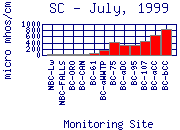 |
|
 |
|
SPECIFIC CONDUCTANCE
Specific Conductance (SC) generally
increases in Boulder Creek as it moves downstream from the mountains to the
plains (for example, see July 1999).
 The increase in SC is partly due to
geologic differences in the watershed, and partly due to humansí effects on
the watershed. The flow rate of Boulder Creek also influences the SC of the water. During high-flow months, such as May and June, SC is often lower because the higher volume of water dilutes ion concentrations.
The increase in SC is partly due to
geologic differences in the watershed, and partly due to humansí effects on
the watershed. The flow rate of Boulder Creek also influences the SC of the water. During high-flow months, such as May and June, SC is often lower because the higher volume of water dilutes ion concentrations.
![]() SC is usually very low at sample sites in the mountains and at
the mouth of Boulder Canyon, where the underlying geology is composed of
granitic and metamorphic rocks, which are resistant to weathering and thus
donít provide a significant amount of dissolved solids to the creek. Samples
collected from the sampling sites at North Boulder Creek at Lakewood
Reservoir, North Boulder Creek Falls, the Orodell station, and at Eben G.
Fine Park had SC values below 150 microsiemens/cm (
SC is usually very low at sample sites in the mountains and at
the mouth of Boulder Canyon, where the underlying geology is composed of
granitic and metamorphic rocks, which are resistant to weathering and thus
donít provide a significant amount of dissolved solids to the creek. Samples
collected from the sampling sites at North Boulder Creek at Lakewood
Reservoir, North Boulder Creek Falls, the Orodell station, and at Eben G.
Fine Park had SC values below 150 microsiemens/cm (
SC increases in Boulder Creek as the creek moves through the city of Boulder. After passing to the east of Boulder, SC values usually ranged from 100 to 300
mS/cm at the 61st Street site and just above the Wastewater Treatment Plant (WWTP). This increase is due to a shift in geology to less resistant sedimentary rocks, and also due to human influences, including runoff from roads, residences, and businesses.At 75th Street, just downstream from the WWTP, SC increases significantly in Boulder Creek, to values between 300 and 900
mS/cm. This increase is due to effluent discharged from the WWTP. While the wastewater from Boulder residences, businesses, and industries is treated to remove most constituents and meets State of Colorado and U.S. Environmental Protection Agency (EPA) requirements, it is impossible for the plant to remove all of the constituents we contribute to the sanitary sewer.Downstream from 75th Street, the SC of Boulder Creek is highly variable, ranging from 100 to 800
mS/cm , with most values between 300 and 600 mS/cm. The SC of lower Boulder Creek often decreases after 75th Street due to dilution. At other times, the SC of lower Boulder Creek increases after 75th Street, indicating a source of dissolved constituents to the Creek at these downstream locations. Increased SC is sometimes observed downstream of the confluence of Boulder Creek and Coal Creek, indicating that Coal Creek sometimes carries a higher dissolved load than Boulder Creek, from leaching of shales in the bedrock and from discharges from other wastewater treatment plants.
COMPARISON TO REGULATIONS
There are no regulations for specific conductance. It is an indirect measure of the presence of dissolved solids.